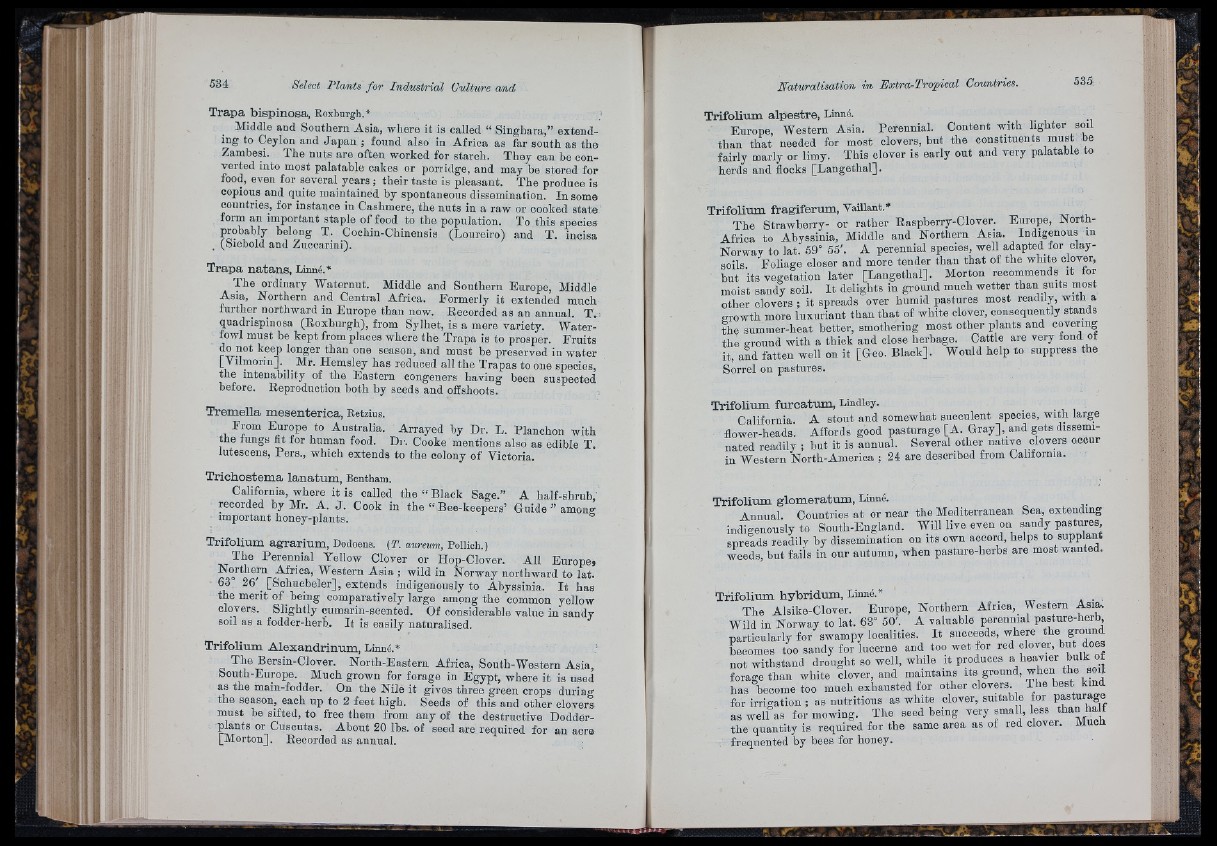
i
í
i,
;1'- í
Trapa bispinosa, Roxburgh.*
Middle and Southern Asia, where it is called “ Singhara,” extending
to Ceylon and Jap an ; found also in Africa as far south as the
Zambesi. The nuts are often worked for starch. They can he converted
into most palatable cakes or porridge, and may be stored for
food, even for several years ; their taste is pleasant. The produce is
copious and quite maintained by spontaneous dissemination. In some
countries, for instance in Cashmere, the nuts in a raw or cooked state
form an important staple of food to the population. To this species
probably belong T. Cochin-Chinensis (Loureiro) and T. incisa
_ (Siebold and Zuccarini).
Trapa natans, Linné.*
The ordinary Waternut. Middle and Southern Europe, Middle
Asia, Northern and Central Africa. Formerly it extended much
further northward iu Europe than now. Recorded as an annnal. T.;
quadrispinosa (Roxburgh), from Sylhet, is a mere variety. Water-
fowl must be kept from places where the Trapa is to prosper. Fruits
do not keep longer than one season, and must be preserved in water
[Vilmorin].^ Mr. Hemsley has reduced all the Trapas to one species,
the intenability of the Eastern congeners having been suspected
before. Reproduction both by seeds and offshoots.
Tremella mesenterica, Retzius.
From Europe to Australia. Arrayed by Dr. L. Planchon with
tbe fungs fit for human food. Dr. Cooke mentions also as edible T.
lutescens, Pers., which extends to the colony of Victoria.
Tricbostema lanatum, Bentham.
California, where it is called the “ Black Sage.” A half-shrub,'
recorded by Mr. A. J . Cook in the “ Bee-keepers’ Guide ” among
important honey-plants.
Trifolium agrarium, Dodoens. (T. aureum, Pollich.)
The Perennial Yellow Clover or Hop-Clover. A ll Europe,
Northern Africa, Western Asia ; wild in Norway northward to lat.
63 26'_ [Schuebeler], extends indigenously to Abyssinia. I t has
the merit of _ being comparatively large among the common yellow
clovers. Slightly cumarin-soented. Of considerable value in sandy
soil as a fodder-herb. I t is easily naturalised.
Trifobum Alexandrinum, Linné.*
The Bersiu-Clover. North-Eastern Africa, South-Western Asia,
South-Europe. Much grown for forage in Egypt, where it is used
as the main-fodder. On the Nilé it gives three green crops during
the season, each up to 2 feet high. Seeds of this and other clovers
must be sifted, to free them from any of the destructive Dodder-
plants or Cuscutas. About 20 lbs, of seed are required for an acre
[Morton], Recorded as annual.
T r if o l iu m a lp e s t r e , Linné.
Europe, Western Asia. Perennial. Content with lighter soil
than th a t needed for most clovers, but the constituents must to
fairly marly or limy. This clover is early out and very palatable to
herds and flocks [Langethal].
T r if o l iu m f r a g if e r um , Vaillant.»
The Strawberry- or rather Raspberry-Clever. Europe, North-
Africa to Abyssinia, Middle and Northern Asia. Indigenous in
Norway to lat. 59° 55'. A perennial species, well atopted for clay-
soils Foliage closer and more tender than th a t of the white clover,
hut its vegetation later [Langethal]. Morton recommends it for
moist sandy soil. I t delights in ground much wetter than suits most
other clovers ; it spreads over humid pastures most readily, with a
growth more luxuriant than th a t of white clover, consequently stands
the summer-heat better, smothering most other plants and covering
the ground with a thick and close herbage. Cattle are very fond of
it, and fatten well on it [Geo. Black]. Would help to suppress the
Sorrel on pastures.
T r if o b u m f u r c a tu m , Lindley.
California. A stout and somewhat succulent species, with large
flower-heads. Aifords good pasturage [A. G r a y ] , and gets disseminated
readily ; but it is annual. Several other native clovers occur
in Western North-America ; 24 are described from California.
T r if o l iu m g lo m e r a tu m , Linné.
Annual Countries at or near the Mediterranean Sea, extending
indigenously to Sonth-England. Will live even on sandy pastures,
spreads readily by dissemination on its own accord, helps to su p p la^
weeds, but fails in our autumn, when pasture-herbs are most wanted.
T r if o b u m h y b r id u m , Linné.*
The Alsike-Clover. Europe, Northern Africa,^ Western A si^
Wild in Norway to lat. 63° 50'. A valuable perennial pasture-herb,
particularly for swampy localities. I t succeeds, where the ground
becomes too sandy for lucerne and too wet for red dover, bu‘
not withstand drought so well, while it produces
forage than white clover, and maintains its ground, when the soil
has become too much exhausted for other clovers. The best kind
for irrigation ; as nutritious as white clover, suitable for pasturag
as well as for mowing. The seed being very small, less than halt
the quantity is required for the same area as of red clover. Much
frequented by bees for honey.